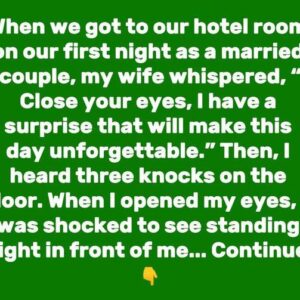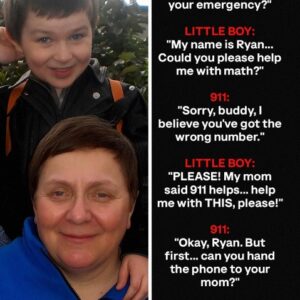I texted my daughter during her college orientation, but hours passed with no reply. By evening, I called—straight to voicemail. Panicked, I called campus security. When they checked her dorm, her things were still in boxes, untouched. An officer asked me to describe her tattoo, then said quietly, “We think we may have found her.”
My knees buckled, and I dropped into the nearest chair. I could hear my heartbeat in my ears as the officer asked me to come to the campus medical center. No further details. Just, “Please come right away.” I told my husband, and we were out the door within minutes.
Our daughter, Leena, had only been at campus for one day. She was always cautious, never the type to party or wander. We’d hugged her that morning, helped her unpack a bit, and promised to call every night. She’d waved us off, full of excitement. And now—this.
At the medical center, a nurse greeted us with a tired but kind face. “She’s okay,” she said immediately. “She’s resting now. But she had an episode. Likely brought on by stress and exhaustion.” I didn’t know whether to cry or collapse with relief.
Leena had been found disoriented, wandering near the campus bookstore. She didn’t remember her name, didn’t recognize her own dorm building. A classmate spotted the tattoo of a small blackbird on her shoulder—the one she’d gotten on her eighteenth birthday—and alerted the staff. That tiny tattoo probably saved her from disappearing entirely.
When we walked into the room, Leena was hooked up to an IV, eyes half-closed, but she smiled when she saw us. “Mom? Dad?” she mumbled. “I’m sorry. I think I just… freaked out.”
The doctors ran tests for everything—blood sugar, infections, even neurological issues—but everything came back normal. Eventually, a quiet psychiatrist in a grey cardigan came in and said gently, “She’s suffering from acute adjustment disorder. Her body and mind just… shut down for a bit.”
I didn’t know that could happen. But the more I thought about it, the more it made sense.
Leena had always carried pressure quietly. Straight-A student. Volunteer work. Piano lessons. Always polite, always helpful. She never complained—not even once—about the expectations we’d unknowingly piled on her. When she got accepted to that competitive university, we’d beamed with pride. “You’ve earned it,” I said. “We’re so proud of you.” But maybe she didn’t feel proud. Maybe she felt trapped.
We took her home that night. She stayed quiet most of the drive, staring out the window with her hoodie pulled up. I wanted to ask a hundred questions—What were you thinking? Are you scared? Why didn’t you say anything?—but instead I just reached over and held her hand.
Over the next few weeks, she saw a therapist regularly. Her school agreed to defer her start until spring semester. We told people she’d had a “health scare,” which wasn’t a lie, just not the full truth. I started noticing how often we’d told her what to do, what to aim for, what’s “best” for her. Every “have you thought about med school?” and “you can’t waste your potential” now echoed in my head like accusations.
One afternoon, while we were cleaning out the garage together, she suddenly said, “I don’t think I want to go back.”
I turned to her. “To college?”
“To that college,” she said, gently. “I picked it because everyone else thought it was impressive. But it doesn’t feel like me.”
I nodded. It stung, I’ll admit. We’d spent years saving up, dreaming of the day our only child would walk those hallowed halls. But I remembered the look on her face in that hospital room. Pale. Dazed. Lost. No school was worth that.
“So what do you want to do?” I asked her.
She shrugged. “I don’t know yet. But maybe something closer to home. Something creative.”
Over the next few months, she took community college classes in graphic design. She got a part-time job at a local art supply store. Her energy slowly returned. Her jokes came back. Even her appetite. One night she told me about a kid who came in looking for charcoal pencils and left with an entire watercolor kit after Leena showed her how to blend colors. She was glowing.
Her therapist encouraged her to explore “safe risk”—things that felt exciting but not overwhelming. She signed up for a local art show. I remember the night she hung her first piece—a blackbird perched on a stack of books—with trembling hands. It sold within the hour.
Her world was changing. But so was mine.
I’d spent years wrapped up in being a provider, a planner, a fixer. I was the mom with a laminated family calendar and color-coded grocery list. But when Leena fell apart, I realized none of that structure had prepared me for what she really needed: space, patience, and permission to be unsure.
Then, out of nowhere, something unexpected happened.
In January, her old university called. A spot had opened in a new art-based honors track they were piloting. Leena had apparently submitted a late application last fall, on a whim, for a program that combined digital design with psychology. The director had seen her portfolio from the local art show and was intrigued. “If she’s still interested,” the voice on the phone said, “we’d love to have her.”
Leena froze when I told her. She stood at the kitchen counter, holding her tea, silent for almost a full minute. Then she said, “I’m not sure.”
This time, we didn’t rush her. She took a week to think about it. Met with the director. Talked to her therapist. And then, one morning, she walked in with a quiet confidence I hadn’t seen in her for a long time.
“I want to try again,” she said. “But this time, on my own terms.”
So we packed her up—again. Same suitcases, different energy. This time, she led the charge. We didn’t unpack her dorm for her. We let her arrange it the way she wanted. I hugged her goodbye and told her, “Call if you want to. Not just because you think you should.”
This time, she replied to every message—not out of pressure, but because she wanted to share her life. Her first dorm meal. Her new roommate, a sarcastic girl from Oregon with purple hair. Her art professor who swore like a sailor but taught like a saint.
Then, a few months into the semester, came the twist none of us expected.
Leena emailed me a photo of a painting she’d done for class. It was massive—four feet tall—and featured a woman made entirely of Post-it notes, each with phrases like “Be better,” “Don’t waste it,” “Smile more.” The woman’s face was tired. But behind her, in the shadows, was a younger version of herself holding a blackbird.
It went viral after being posted by her professor.
Soon, an editor from a small publishing house reached out. They were curating a collection of art pieces and essays about young adults and pressure culture. Would Leena be interested in contributing?
She was stunned. “Me?” she kept saying. “I’m not… I’m not famous or anything.”
But she said yes. She submitted the painting, along with an essay titled The Blackbird on My Shoulder, where she wrote about breaking down during college orientation, her tattoo, and the quiet expectations that nearly drowned her.
The book came out the following year. Her piece was featured on the back cover. And what happened next still brings tears to my eyes.
At a local bookstore event, a girl no older than sixteen approached Leena with tears in her eyes. “I showed your essay to my mom,” she said. “It helped her understand why I’ve been struggling. Thank you.”
Leena didn’t know what to say. She just hugged the girl.
That moment, I think, mattered more to her than any fancy degree or internship ever could.
Today, Leena works as a freelance designer. She also leads workshops for students dealing with academic anxiety. Sometimes she brings her blackbird painting along and tells her story.
Not the polished version. The real one. The one that includes panic, therapy, do-overs, and the power of saying, “I don’t know.”
And me? I’ve changed, too. I listen more now. I don’t plan every second. I’ve learned that the most important thing I can offer my daughter isn’t advice—it’s support.
So here’s what I’ve learned: Sometimes our kids don’t need us to pave the road—they need us to step aside so they can choose their own path. Even if that path looks different from the one we pictured.
Because when they do, they often surprise us—in the best ways.
If you’ve ever struggled with letting go or watched someone you love find their own way, I hope Leena’s story resonates.
If it does, give it a share. Someone else might need to hear it, too.





